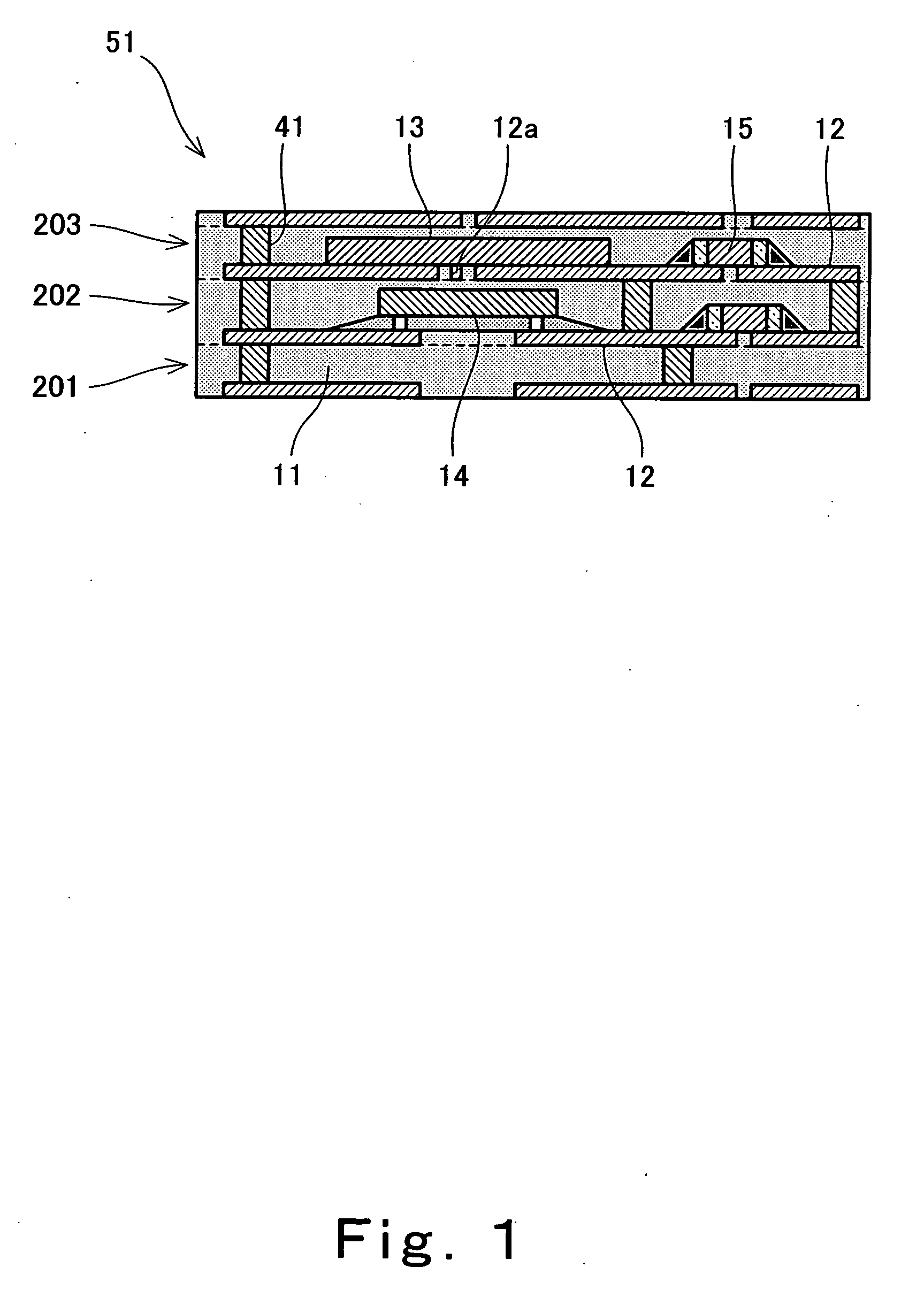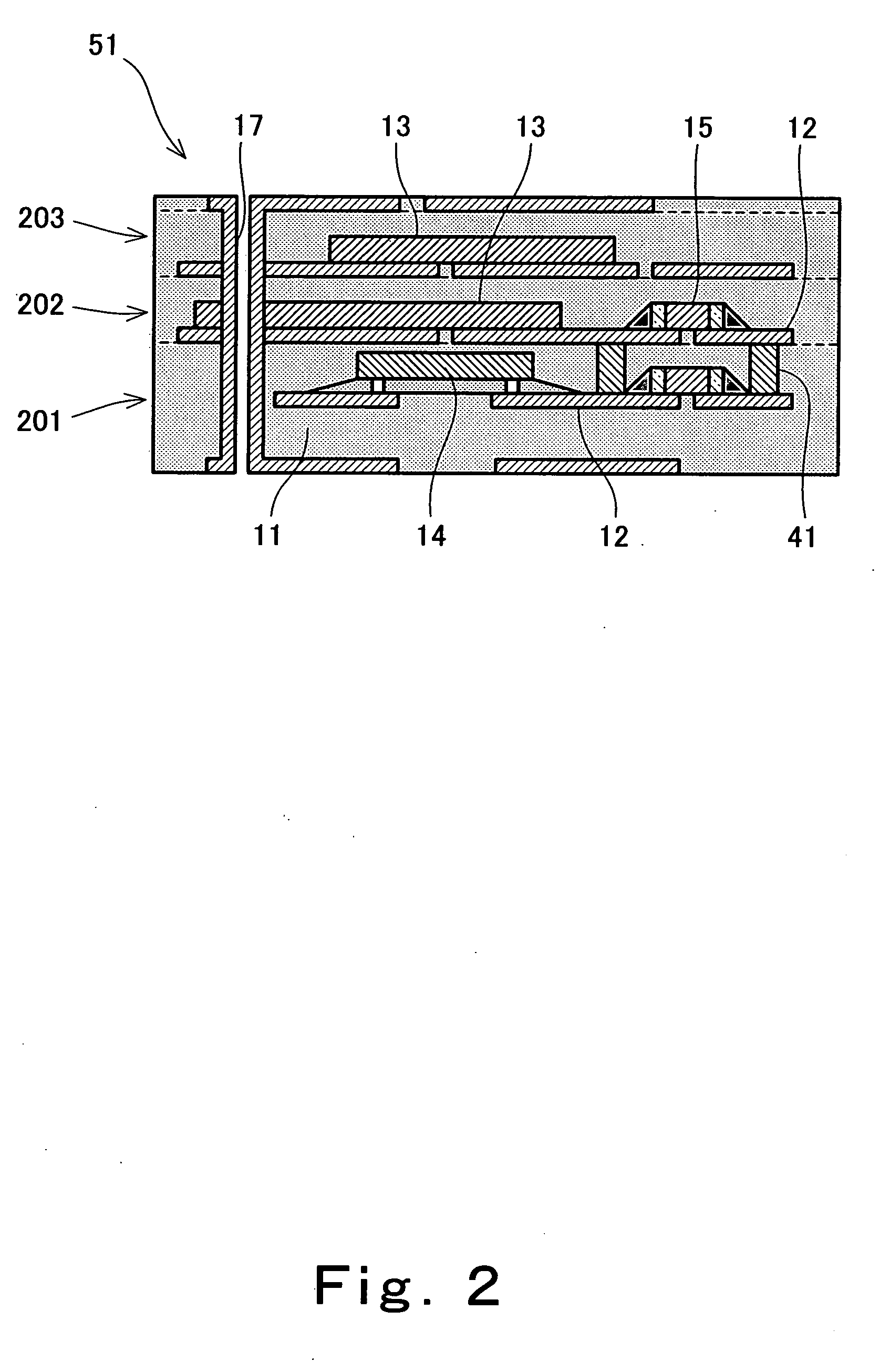Module with built-in circuit elements
a technology of built-in circuit elements and modules, which is applied in the direction of printed circuit components, printed circuit non-printed electric components association, printed circuit manufacturing, etc., can solve the problems of overheating, damaged embedded circuit elements, and increased power consumption of electronics devices, so as to achieve stably released heat, reduce heat resistance between high heat generating circuit elements and heat sink members
- Summary
- Abstract
- Description
- Claims
- Application Information
AI Technical Summary
Benefits of technology
Problems solved by technology
Method used
Image
Examples
first embodiment
[0106] Reference is made to FIG. 1 to describe a first embodiment of the invention.
[0107] The first embodiment of the invention is associated with a first example of cases where other members than circuit elements are used as a heat sink member having high thermal conductivity, the members being made from a metal, ceramics or the like.
[0108]FIG. 1 is a sectional view diagrammatically showing the structure of a module with built-in circuit elements according to the first embodiment of the invention.
[0109] The module with built-in circuit elements 51 shown in FIG. 1 has (a) an electrically insulating material 11; (b) a plurality of wirings (wiring patterns) 12 and signal patterns 12a which are adhered to the electrically insulating material 11; (c) an inner via hole 41 which electrically interconnects the plurality of wirings 12 so as to have a specified connecting relationship; (d) circuit elements 14, 15 which are embedded so as to be electrically connected to the wirings 12 and ...
second embodiment
[0121] A second embodiment of the invention will be described with reference to FIG. 2.
[0122] The second embodiment of the invention is associated with a second example of cases where other members than circuit elements are used as a heat sink member having high thermal conductivity, the members being made from a metal, ceramics or the like.
[0123]FIG. 2 is a sectional view diagrammatically showing the structure of a module with built-in circuit elements according to the second embodiment of the invention.
[0124] The module with built-in circuit elements 51 shown in FIG. 2 has (a) the electrically insulating material 11; (b) the plurality of wirings 12 adhered to the electrically insulating material 11; (c) a plurality of inner via holes 41 which electrically interconnect the plurality of wirings 12 so as to have a specified connecting relationship; (d) the circuit elements 14, 15 which are embedded so as to be electrically connected to the wirings 12 and heat-conductively connecte...
third embodiment
[0126] A third embodiment of the invention will be described with reference to FIG. 3.
[0127] The third embodiment of the invention is associated with a third example of cases where other members than circuit elements are used as a heat sink member having high thermal conductivity, the members being made from a metal, ceramics or the like.
[0128]FIG. 3 is a sectional view diagrammatically showing the structure of a module with built-in circuit elements according to the third embodiment of the invention.
[0129] The module with built-in circuit elements 51 shown in FIG. 3 has (a) the electrically insulating material 11; (b) the plurality of wirings 12 adhered to the electrically insulating material 11; (c) the plurality of inner via holes 41 which electrically interconnect the plurality of wirings 12 so as to have a specified connecting relationship; (d) the circuit elements 14, 15 which are embedded so as to be electrically connected to the wirings 12 and heat-conductively connected ...
PUM
 Login to View More
Login to View More Abstract
Description
Claims
Application Information
 Login to View More
Login to View More - R&D
- Intellectual Property
- Life Sciences
- Materials
- Tech Scout
- Unparalleled Data Quality
- Higher Quality Content
- 60% Fewer Hallucinations
Browse by: Latest US Patents, China's latest patents, Technical Efficacy Thesaurus, Application Domain, Technology Topic, Popular Technical Reports.
© 2025 PatSnap. All rights reserved.Legal|Privacy policy|Modern Slavery Act Transparency Statement|Sitemap|About US| Contact US: help@patsnap.com



